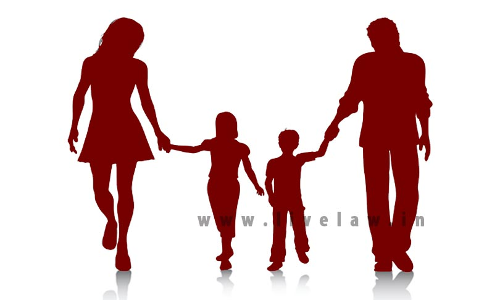
In the past few decades, family law jurisprudence in India has compelled us to think about the entrenched patriarchy in our society specifically in the realm of custody and domestic violence. It is important to explore the current system of cross cultural child custody during a divorce or separation with reference to the contradiction in the standards of -'best interests of the child'...
In the past few decades, family law jurisprudence in India has compelled us to think about the entrenched patriarchy in our society specifically in the realm of custody and domestic violence. It is important to explore the current system of cross cultural child custody during a divorce or separation with reference to the contradiction in the standards of -'best interests of the child' and his/her need for flexibility, as opposed to one favouring parental need for finality.
Brief Overview of Custody under Indian Law
In India, custody is granted through the provisions delineated in The Guardians and Wards Act 1890 (GWA), by the personal laws of the parties, (partly customary and partly codified) which are given in statutes such as the Hindu Minority and Guardianship Act 1956 and the marriage and divorce laws of Hindus, Muslims, Parsis and Christians. Generally all these laws require courts to give due weightage to the best interest of the child.
It is pertinent to note that the various factors which the courts take into consideration have not been laid down exhaustively in any form and there are no standards/guidelines given to deal with children's concerns in family courts. Over the years though, each determination has been done on a case by case basis and a comprehensive study has brought forth some of the following factors-
- Thirty Hoshie Dolikuka v. H.S. Dolikuka- Whether a woman works or not is irrelevant in judging her ability to take care of her child and cannot be denied custody just because she is working.
- In the case of Suresh Babu v. Madhu the time which a parent can devote to their child/children was given importance.
- In the case of Bhagyalakshmi v. K Narayanna Rao and Jaswant Kaur v. Manjit Singh, relative economic standing was studied and the parent with better financial dependence was given custody. However it was later elaborated that in case the father has better financial standing, the time he can devote and the love and care he can impart to his child/children should also be considered.
- In the case of Chethana Ramatheertha vs Kumar V. Jahgirdar it was held that in the custody of the minor children, "the consideration can only be the welfare of the child and the rights of the parents has to yield or give way". It was also noted that the question of custody must not viewed any more from the angle of "which parent has a better right", but from the approach as to "the company of which of the two parents is better suited for the integrated development of the personality of the child" and "as to whether the child receives the necessary inputs if it is in the company of a particular parent, for a healthy growth and development of the personality of the child".
Caste and Religion in Custody
As the law has progressed and contemporary India has welcomed the intersection of religious identities and cultures, it has brought with it multiple challenges, especially in the realm of divorce (conversion) which has led to long drawn custody battles for children. Unfortunately, family law jurisprudence where religion has been the sole basis of the denial or grant of custody to one parent is still evolving and there has not been a potential breakthrough addressing specific cultural concerns. A potential reason for such a situation is that in a secular country like India, judges refrain from addressing custody disputes rooted in religion because that would involve a determination where he/she will have to rationally consider one religion superior to the other. A man governed by law is not equipped to determine (albeit if done rationally) that Islam is better than Hinduism/Christianity/Judaism etc. Apart from the political brouhaha and the demographic irregularities (due to presence of multiple castes/cultures/religion) it can lead to, this can pose multiple challenges with reference to the factors employed to arrive at that conclusion and arguably go against secularity enshrined under the constitution.
To clarify the position of the courts in India, it is pertinent to look at some past judgments where reference has been made to religion and culture in custody cases or have been contended to be grounds, among others, for custody.
In the case of Ram Kawal Yadav vs Pratibha Yadav the learned judge of the High Court of Madhya Pradesh, while granting custody to the mother noted the caste differences of the mother and the father and opined that it "would result in the change of family atmosphere as well as change in his cultural and social environment [and] it may not be conducive to the interest of the minor and may adversely affect his future prospects and career". He observed that the differences in the caste and the difference in the cultural paradigm could lead to a wide disturbance in the child's life and considered it to be a pertinent issue while granting custody.
Similarly, in the case of Smt. Sangeeta Atre vs Home Department the respondents in the High court of Madhya Pradesh had contended that the child's father and paternal family "are Rajpoot by caste and, therefore, the child born in the family must remain with the family." It was also stated that "since, the petitioner has solemnized marriage in different caste, though in Hindu community, it is a blemish to the family of Rajpoot, therefore, she has no legal, moral or customary right to have the custody of the child. Since the child is born in Rajpoot family, therefore, she must be brought up with traditions, customs and rich Rajpoot culture.
This argument was vehemently dismissed by the judge and he had opined that it "is in despair and more of disgust than of substance".
When compared with the case of Ram Kawal Yadav vs Pratibha Yadav [supra] it is easy to spot the contradiction where one court chooses to uphold case and culture as an important factor in a child's life whereas the other dismisses it without recording any justification.
Again, in the case of Mr. Rajan Chawla vs Mr. Lisbon John Miranda, religion was contended to be an essential reason to seek custody of a minor child. In this case the paternal aunt of the minor had submitted that "the child must be brought up as a Roman Catholic. Catholic Rituals must be performed and she must attend a Convent School where the ideals of the Christianity would be taught." The aunt had also expressed her desire to baptise the child and perform similar rituals to convert her to a Catholic.
On this issue Justice Dalvi had astutely opined that- "The concept of religion in Section 17(2) has been misinterpreted by the aunt. It does not contemplate…that in our patriarchal Society only the religion of the husband must prevail. That argument and such interpretation is directly contrary to the freedom of religion under the Constitution of India and will be gender discriminatory where each individual is allowed to profess and practice the religion of his or her choice and respect for all religions is enjoined. There is no greater religion amongst the great religions. What is to be understood in consideration of the religion of the minor is that a minor who has been brought up upon the tenets of any of the great religions be not disturbed by thrusting upon the minor the tenets or traditions of another religion which would cause stress and trauma upon the minor during the delicate years of his/her growth...….. There is no reason for any upheaval by any disturbance of that state of affairs. Consequently, in fact considering that the minor has been exposed to the Hindu religion, which none can fault, the application of the aunt that certain ceremonies of Christianity, hitherto not performed are now required to be performed demonstrates the desire to disrupt the peaceful environment and surroundings of the child...?"
This judgment presents a refreshing opinion where the effect of a patriarchal society on a child is recognised and his/her peace and upbringing is prioritised. The court has naturally evaded from commenting on the religious practices and refused to compare them by stating that "There is no greater religion amongst the great religions."
By employing this approach the court has managed to uphold the unique secular culture of the country and given the much needed importance to the child and his/her needs.
However, it is to be noted that in none of the judgments religion has been considered as the only isolated factor to grant or deny custody to a child, and the economic, social, cultural differences along with the capacity of the parent and the welfare of the child are studied together.
Further, a deeper study of these judgments also shows that as far as possible, courts evade addressing the concept of religion as a ground for custody altogether and employ certain measures. For instance mediation is always mandated, and often the child (when, older than 7 or capable of giving independent preference) is asked to express his choice. Additionally, the courts, in many unavoidable circumstances simply give the final judgment (where religion is the bone of contention) without recording any rational basis or reasoning for it, which enables it to circumvent scrutiny in the public sphere.
Patriarchy and Domestic Violence under Protection of Women from Domestic Violence Act, 2005 ("PWDVA")
To nobody's surprise there have been many instances in India especially evident in the COVID pandemic which have brought to the fore the prevailing issue of domestic violence and its impact on a child. The violence inflicted on women is generally a result of a patriarchal society and the complex and inter-connected institutionalised social and cultural factors to which she is subjected.
The country is no stranger to the unequal power relations between men and women. The gender specific socialization, cultural definitions of appropriate gender roles, expectations of roles within those relationships, notions of family as the private sphere under the control of males, doctrine of family privacy and the acceptability of violence as a means to resolve conflict have all cumulatively become substantial contributing factors and the root causes of domestic violence in India today.
In this section I will try to lay out the law for domestic violence, and will restrict my analysis to PWDVA ("Act") which is a leading legislation on the issue.
The PWDVA is arguably touted as a progressive legislation in India because it has identified and attempted to resolve the lacunae in family law jurisprudence. As a product of a long driven campaign it manages to make provisions for women's issues in detail, 'recognizes' women who are in live in relationships, includes all sexual partners of a male under the definition of 'aggrieved persons', protects other women in the household and moves away[1] from the primitive notion of abuse. It also gives a wide ambit to the term 'domestic violence' and gives a comprehensive definition of 'physical violence'. Additionally, it is the first such legislation which has expanded 'domestic violence' to include sexual, verbal and economic violence and has catered for the compensation for torture and emotional distress caused to the victim. Apart from providing a range of procedural provisions to make it easier for the aggrieved it also gives leeway to 'any person to lodge a complaint, who has reasons to believe' that any act resembling domestic violence as defined has been committed against another (this discards the provision where only directly affected/aggrieved persons are allowed to lodge complaints).
While the PWDVA has certainly been a step in the right direction, it is argued that its implementation by the judiciary has grave patriarchal connotations albeit slightly different than what was seen in the movie -Not without my daughter.
Some pronounced issues in PWDVA include (but are not limited to)-
- Budgetary and Infrastructural Limitations: "Even though the legislature has enacted the law with a view to bring equality into the home, its success depends on the extent to which the required support services are put in place by the State". So far the center has not rolled out uniform guidelines which directs them to earmark a certain amount of funds for necessary facilities such as appointment of Protection Officers (mandated under Section 2 of the PWDVA to act as the points of contact between the victim and the court/all functionaries under PWDVA), notification of service providers, training and capacity building of different functionaries such as the police and the judiciary along with extensive awareness generation programs. This lack of funds has hindered the implementation and has led to states employing different methods for reservation which has drastically impacted the quantum reserved. Additionally, it has given liberty to the states to dilute funding meant for PWDVA and direct it to other schemes and plans.
- Diluted Interpretation of PWDVA by the Courts: Indian courts have been accused of misinterpreting the words of the act in order to reduce its scope. For instance in S R Batra vs Таrunа Batra, the Supreme Court held that, "the wife is entitled to claim a right to residence in a shared household, and a "shared household" would only mean the house belonging to or taken on rent by the husband, or the house which belongs to the joint family of which the husband is a member". This effectively excluded all self-acquired property of in-laws from the purview of shared household, even if the aggrieved had been living there since marriage. Though, this has been overruled in Satish Chander Ahuja v Sneha Ahuja where the court stated that the definition of a shared household was not 'happily worded' in SR Batra, and it interpreted it to mean- "shared household of aggrieved person [is]where she was living at the time when application was filed or in the recent past had been excluded from the use or she is temporarily absent". While this interpretation does acknowledge and incorporate the intent of PWDVA to some extent, it fails to guarantee or provide any safeguards that the wife will not be suppressed and exploited in that shared household and still deviates from the scope and the object of the legislation.
It is also pertinent to note that the High court judgments have tried to alter the ruling in SR Batra. For instance in P Balu Venkatesh vs Rani, the husband, 'after dispossessing the wife, had
transferred the premises in the name of his father and relied on the Batra judgment that his wife was not entitled to claim relief against his parents. The single judge of the Madras High Court observed that 'if this contention is accepted, every husband will alienate his property in favour of someone else after the dispute has arisen and plead that the premises do not constitute "shared household" under the act and hence the wife would not be entitled to claim the right of reside'.
However, these rulings require a great deal of effort from reputed lawyers, who are inaccessible to the general public. These positive rulings then fail to trickle down to the level of magistrates due to which the lower courts are more aware of the negative interpretations which is materialized in the justice served at the lower level. So what should have been a guaranteed remedy under the statute, requires a great deal of effort with no guarenteed results.
Additionally, in D Veluswamy vs D Patchaimal, the Supreme Court deviated from the objective of PWDVA and interpreted the term "relationship in the nature of marriage" to hold that, "not all live-in relationships will amount to a relationship in the nature of marriage to get the benefit of the act". The apex court here, also broke down a live-in relationship into a mere monetary contract and depicted the steep patriarchal approach Indian Courts can take regarding domestic abuse. This was evident in Justice Katju's classification of women in live in relationships as "mistresses" and "keeps."
Due to this, the judgment invited a lot of controversy and negative publicity which ultimately made the implementation of PWDVA impossible in magistrate courts as the courts declined to entertain these applications.
Other Limitations: PWDVA also fails to include domestic violence suffered by domestic help, and fails to address domestic abuse faced by members in the family who aren't women. It also excludes violence by, for instance- a married couple against an older member, which is something which falls into the scope of domestic violence in various international legislations[2]. Additionally, a few of its provisions have been deemed to be impractical due to an already overburdened judicial system. For instance Section 12 (4) makes it mandatory for the magistrate to hear a case within three days of the complaint being filed and Section 12 (5), directs the magistrate to finish hearing the case within six months of it reaching the court.
These are merely two major issues in family law jurisprudence in the Indian legal system on custody, based on religion and domestic violence. The country is also riddled with multiple other socio-cultural and demographic issues which have not been addressed. For instance – there is still no standardized approach which can equip courts to give the maximum priority to a child's welfare in the cases of custody and a woman's needs and wellbeing in the case of domestic violence.
Even though a positive step in the right direction has been taken, the courts' subjectivity and underlying patriarchal norms make it difficult for women in India to claim their rights and achieve a normative standard of equality.
Views are personal.
Also read: Child Has Right To The Affection Of Both His Parents;
[1] 'abuse' includes actual abuse or threat of abuse, whether physical, sexual, verbal, economic and harassment by way of dowry demands, and thus, under the new law, harassment by way of unlawful dowry demands on the women or her relatives also comes under this definition
[2] S.2, Malaysian Domestic Violence Act, 1994, which includes a spouse, former spouse, children, mentally incapacitated adults, and any other family member, as aggrieved parties. Similar progressive domestic violence legislations have been passed in Australia [Family Law Reform Act, 1995], United Kingdom [Family Law Act, 1996],and South Africa [Domestic Violence Act,1998].




